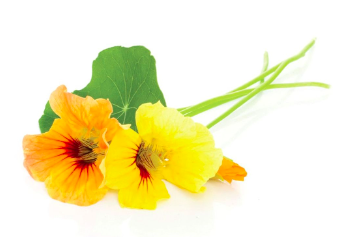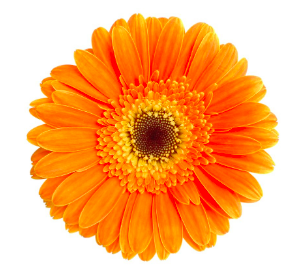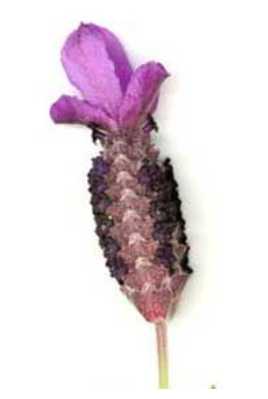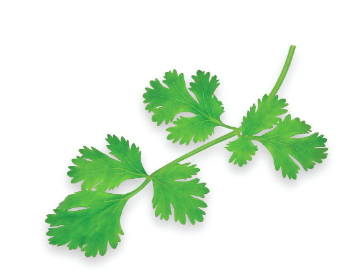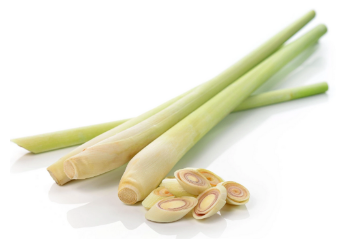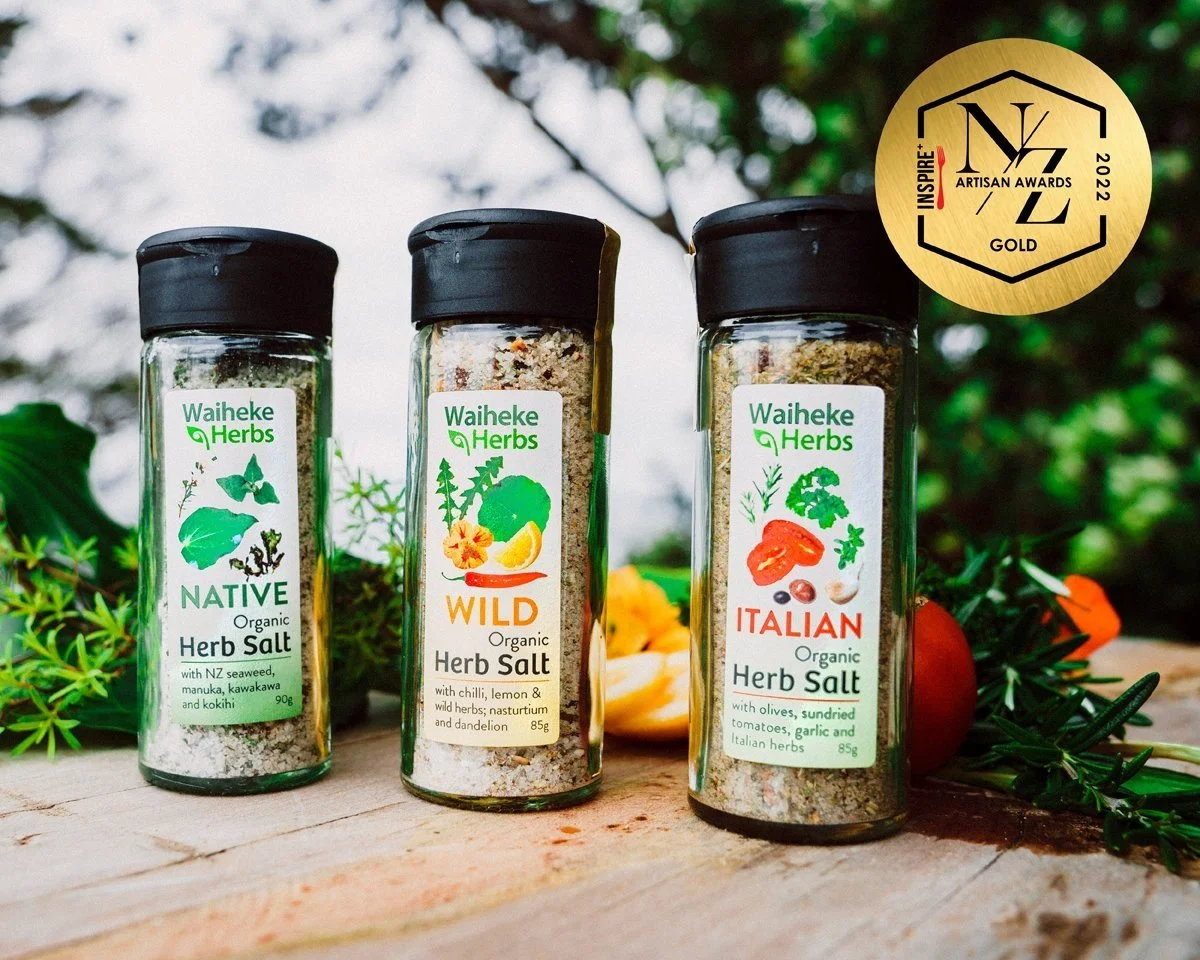
About Our Herbs
Parsley - petroselinum crispum
The Superfood Herb
Contains: Parsley is a source of flavonoids and antioxidants, especially luteolin, apigenin,[10] folic acid, vitamin K, vitamin C, and vitamin A. Half a tablespoon (a gram) of dried parsley contains about 6.0 µg of lycopene and 10.7 µg of alpha carotene as well as 82.9 µg of lutein+zeaxanthin and 80.7 µg of beta carotene.[
Health Benefits: Serves as an anticancer powerhouse, fights diabetes, promotes bone health, boosts immune system, a natural antibiotic, keeps the heart healthy, detoxifying.
Culinary Uses: A versatile flavour for almost any meal - particularly liked by most children!
Used in Mediterranean, European, English and American cuisine.
Rosemary - rosmarinus officinalis
The Herb of Remembrance (for soldiers lost in war, or as love charm for new brides!)
Contains: a number of phytochemicals, including rosmarinic acid, camphor, caffeic acid, ursolic acid, betulinic acid, carnosic acid and carnosol.[18]
Health Benefits: used to treat a wide variety of ailments over many centuries including digestive and respiratory complaints, or to improve the memory and circulation. ....Find out more
Culinary Uses: Native to the Meditteranean, the bitter flavour goes well with meats, cheeses and most dishes! Also makes a delicious herbal tea.
Considered a sacred plant! deters unwanted insects in the garden, but still loved by the bees especially as it flowers during winter in NZ. Loves to grow by the sea!
Sage - salvia officinalis
The Purifying Herb (burned in ceremonial cleansing by English monks and American Indians)
Contains: tannic acid, oleic acid, ursonic acid, ursolic acid, carnosol, carnosic acid, fumaric acid, chlorogenic acid, caffeic acid, niacin, nicotinamide, flavones, flavonoid glycosides, and estrogenic substances
Health Benefits: used since ancient times as a diuretic, (reducing water retention), a local anesthetic for the skin, a styptic, (stop bleeding), diuretic, emmenagogue, (assist women's hormones/cycles) and tonic.... Anti-bacterial properties used for hair care, insect bites and wasp stings, nervous conditions, mental conditions, oral preparations for inflammation of the mouth, tongue and throat, and also to reduce fevers.[7] Find out more
Culinary Uses: Many olde English recipes require the pungent, minty flavour of sage (not in favour by the French!) to flavour meats, stews, bread etc. A strong, minty flavour.
There are so many types of sage - I especially love purple sage, and often make a tea to soothe sore throats or headaches.
Thyme - thymus vulgaris
The Herb of Courage (placed under pillows or gifted to soliders on their way to war)
Contains: compounds such as p-cymene, myrcene, borneol, and linalool.[9]
Health Benefits: Thymol, an antiseptic, is an active ingredient in various commercially produced mouthwashes such as Listerine.[10] Before the advent of modern antibiotics, oil of thyme was used to medicate bandages.[2] It has also been shown to be effective against various fungi that commonly infect toenails.[11] Thymol can also be found as the active ingredient in some all-natural, alcohol-free hand sanitizers. A tisane made by infusing the herb in water can be used for coughs and bronchitis.[8] Find out more
Culinary Uses: A classic herb in a Bouquet Garni, Thyme has traditionally been used to flavour soups, stews, meats, stuffing, savoury muffins etc. Pungent and aromatic.
Bees love thyme flowers! and infuse their honey with this unique flavour.
NZ Spinach / Kokihi - Tetragonia tetragonioides
The Seaside Herb
Contains: a rich source of iron, Vitamins A, C, K (styptic), Vitamin B6, Manganese and smaller quantities of iron, Vitamin B2(riboflavin), Vitamin E, Zinc, Calcium, Magnesium
Health Benefits: Used to treat scurvy by Captain Cook, and as a generally nourishing plant by Maori, Australians and South Americans where it is considered an edible weed Find out more
Culinary Uses: A tasty alternative to spinach - used in salads in most of the finest restaurants in South America, (Peru). Grows wild happily in many coastal areas of New Zealand.
I love the tiny crystals dotted all over the fleshy leaves of this plant! and how it pops up all over the garden wherever it likes - being tricky to cultivate where you want it!
Nasturtium - tropaeolum
The Trophy Herb - named after resemblance to shields and helmets - presented after battles for Viking warriers who returned!
Contains: The flowers contain about 130 mg vitamin C per 100 grams (3.5 oz),[24] about the same amount as is contained in parsley.[25], 45 mg of lutein per 100 g, [26] which is the highest amount found in any edible plant. Also high in sulphur - a natural antibiotic.
Health Benefits: antiseptic and expectorant qualities.[24] assist chest colds, promotes the formation of new blood cells.[24] also respiratory and urinary tract infections.[28] Find out more
Culinary Uses: The very spicy and sweet flavour of both the leaves and flowers are a tasty and colourful addition to salads. Use the leaves to wrap rice salads/dolma (instead of grape leaves)
Nasturtiums grow vigorously in most wild places all year around on Waiheke! but are very easy to remove if you find they are taking over! Also helps to fix nitrogen back into the soil
Plantain - plantago minor
The Field Herb (Ancient herbal folklore worships this humble herb for it's healing properties)
Contains: High in mucilage- a glutinous substance similar to that found in aloe vera which has a soothing effect on the digestive system, reducing inflammation and gas.
Health Benefits: astringent, anti-toxic, antimicrobial, anti-inflammatory, anti-histamine, as well as demulcent, expectorant, styptic and diuretic.[4] [28] Also used as a poultice to stop bleeding or heal wounds, snake bite or insect stings. The bitterness stimulates digestion Find out more
Culinary Uses: The slight bitterness doesn't appeal to most palates in modern cuisine, although the fresh aroma of cut grass / corn is somehow appetising! Chopped finely into salads or smoothies will boost your vitamin intake and help with any digestive complaints! * Found growing wild all over the world!!!
Dandelion - taraxacum officinale
The Ancient Herb (Fossils have been found from the glacial era 15,000 years ago)
Contains: flavonoids including luteolin, apigenin, isoquercitrin (a quercetin-like compound), caffeic acid, and chlorogenic acid. Also terpenoids, triterpenes, and sesquiterpenes.
Very high in Vitamins A, B1, B2, B6, C, E and K. Calcium, Iron, Manganesium, Manganese.
Health Benefits: Dandelion has been used to treat a wide variety of ailments throughout history, including most internal / digestive, and external / skin complaints. Scientific tests have proven anti-inflammatory, anti-carcinogenic and anti-oxidative qualities. Find out more
Culinary Uses: As with plantain, the bitter taste limits culinary appeal. However, blended with other ingredients in salads, soups or smoothies, dandelion leaves provide a concentrated intake of important nutrients, and aid healing without being too distasteful! Try steaming the flowers with sunflower oil, salt and garlic! DELICIOUS! Easy to consume in Herb Spread ; )
Calendula - family asteraceae - calendula officinalis
The Sun Herb (Harnessing the healing energy of the sun - derived from calendar/sun's path)
Contains: (in the petals) flavonol glycosides, triterpene oligoglycosides, oleanane-type triterpene glycosides, saponins, and a sesquiterpeneglucoside.[7][8
Health Benefits: For centuries, Calendula petals have been used to create potions for healing skin ailments and in teas/salads for internal health. Scientific testing has proven antihemorrhagic, antiviral, anti-inflammatory and antiseptic properties - helping to detoxify the liver, aid women's health, slow bleeding and heal wounds. Find out more
Culinary Uses: The golden petals look beautiful in salads, and in ancient times were used to colour butter and cheese.
Calendula is so easy to grow - self-seeds everywhere, and adds sunny colour to your garden!
Lavender - lavandula stoechas
The Holy Herb (Used in biblical times to prepare holy essence or for cleansing)
Contains: linalool (26%) caryophyllene (8%).[31]
Health Benefits: used over centuries for it's healing, aromatic and calming effects, recent scientific testing has proven antiseptic and anti-inflammatory, properties.
Lavandula Angustifolia is generally used for fragrant and healing purposes
Lavandula grosso lisso is sweet scented - best suited for perfume.
Lavandula dentata is the common hedge variety - flowering most of the year round.
Lavandula Spika is very strong - best used for anti-septic potions.
Find out more - wikipedia Find out more - Happy DIY Home
Culinary Uses: We have chosen the Stoechas variety for our Herb Spread because of it's perfect culinary flavour - minty and fresh. According to research, this was the original variety first mentioned in ancient Greece. Referenced in French cuisine for flavouring shortbread, salads, cheeses and dressings, scone and even marshmallow! and in America for custards, desserts, sugar and honey.
The leaves are often used instead of Rosemary for a milder flavour for teas or savoury meals.
Our Herb spread features the leaves in autumn- winter and flowers in spring - summer
Coriander - coriandrum sativum
Also known as Chinese Parsley, or Cilantro
Contains; vitamin A, vitamin C, and vitamin K, with moderate content of dietary minerals.
Found in Southwestern Asia, Northern Africa and Southern Europe. Oldest evidence of culinary use is 8000yrs ago - it was also found in the tomb of Tutankhamun and mentioned by Hippocrates from Greece.
Some people have a gene which detects the odour of dish-soap/green beetles - almost 25%!
Often used in Asian cuisine. The seeds are also used in Indian, Asian and European cuisine.
Lemongrass - Cymbopogon
The name cymbopogon derives from the Greek words kymbe (κύμβη, 'boat') and pogon (πώγων, 'beard') "which mean [that] in most species, the hairy spikelets project from boat-shaped spathes." Lemongrass and its oil are believed to possess therapeutic properties.
In India, C. citratus is used both as a medical herb and in perfumes. C. citratus is consumed as a tea for anxiety in Brazilian folk medicine but a study in humans found no effect. In the Caribbean, the tea is also brewed and consumed to boost immunity. In the Philippines, it is called Tanglad, and can boost health benefits for liver and kidney. One study found the tea may exert an erythropoiesis boosting effect.
In Hoodoo, lemongrass is the primary ingredient of van van oil, one of the most popular oils used in conjure. Lemongrass is used in this preparation and on its own in hoodoo to protect against evil, spiritually clean a house, and to bring good luck in love affairs.
In beekeeping, lemongrass oil imitates the pheromone emitted by a honeybee's Nasonov gland to attract bees to a hive or to a swarm. Find out more - Wikipedia






